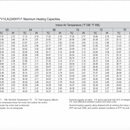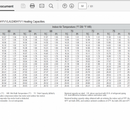Looking for help understanding minisplit specs
Attached is a screen shot of the maximum heating capacity chart for an LG mini split I’m looking at. Also, there is a second chart label “heating capacity.” What’s the difference?
I see wildly different prices for different units and just trying to find the right fit for my application.
GBA Detail Library
A collection of one thousand construction details organized by climate and house part











Replies
Heating capacity would be the rated capacity. I've never seen a table like that with so many different temperatures. Without knowing the COP, knowing the rated capacity isn't very useful. They do include the power input, so I guess you could extrapolate it.
To calculate COP:
C / PI*3.41
where C = capacity in kBTU/h, PI = power in in kW
The COP is 3.61. The information is from the engineering manual for the unit which is chock full of things I don't understand.
I understand what you mean by rated capacity but what's the difference between "heating capacity" and "maximum heating capacity." Because the output looks quite different.
The COP varies by load and conditions.
Heating capacity in that table = rated capacity. Max capacity is pretty self explanatory, it's the most it can put out. The rated capacity is some intermediate figure, presumably chosen based on optimal compressor and fan output. For the purposes of comparing specs, it's really just another data point at which you can look at the efficiency. If your load at a particular temperature is close to the max capacity, then the rated capacity is meaningless to you (at that particular temperature).
According to Shawn LeMons at Mitsubishi:
-----------------------
"- The "rated capacity" is the output of the unit at specified AHRI test conditions. For example, rated capacity for heating at 47°F outdoor dry bulb (DB) is tested at 43°F outdoor wet bulb (WB) and 70°F indoor DB. This test also locks the frequency of the inverter at 60 Hz. This doesn't help the functionality and efficiency of the system. But it keeps the test consistent with typical 60 Hz systems.
- The "maximum capacity" is the approximate output tested by the manufacturer when the system is allowed to operate as engineered, modulating as needed for performance.
- Because this is a Hyper Heat cold climate unit, the output at 5°F is effectively 100% capacity as stated in the spec sheet and unadjusted for altitude. "
-----------------------
See response #11 in this thread:
https://www.greenbuildingadvisor.com/question/are-these-calculations-wrong
I was unaware of the AHRI test requirement to lock the inverter frequency to 60Hz, which seems pretty sub-optimal. It helps in "apples to apples" comparisons I suppose, but binding two legs of a dog to be able to compare it's running ability with that of a chicken doesn't really tell you very much about either. Perhaps a fully modulating system can't be fairly compared to 60Hz 1 or 2 stage heat pumps. They are similar, but still different species- more of an apples-to-pears scenario. That aspect of the AHRI test is a bit like stuffing a pear into an apple mold.